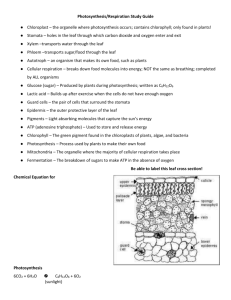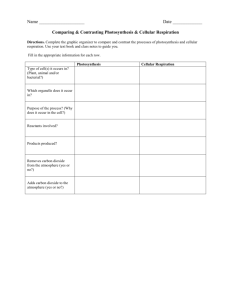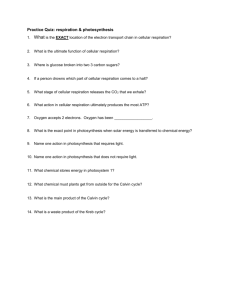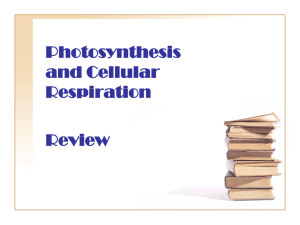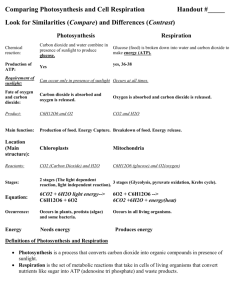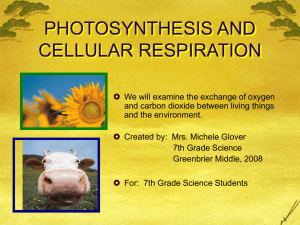Photosynthesis and Respiration
advertisement
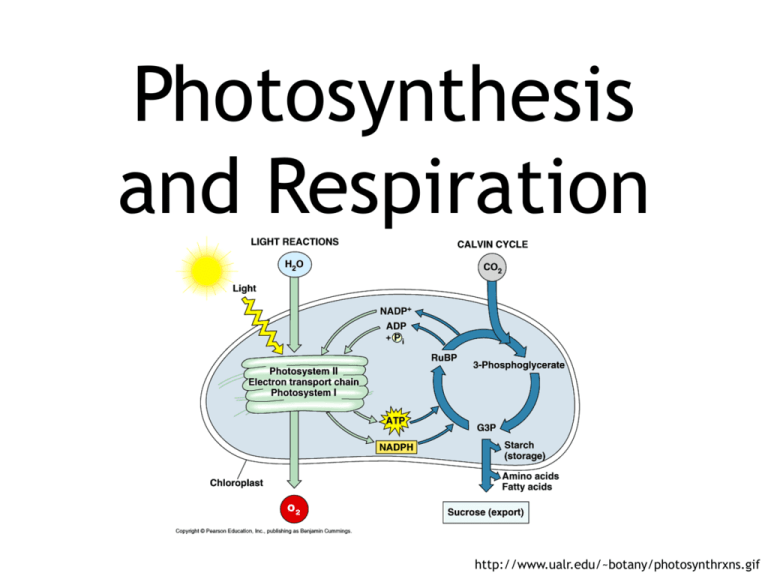
Photosynthesis and Respiration http://www.ualr.edu/~botany/photosynthrxns.gif Definitions • Photosynthesis – How a Plant Harnesses Light Energy to Make Chemical Energy • Respiration – Turning Chemical Energy into Fuel for Growth, Development and Reproduction Photosynthesis http://www.ualr.edu/~botany/photosynthesis.gif Leaves and Leaf Structure • The Raw Materials of Photosynthesis Enter the Cells of the Leaf – Water and Carbon Dioxide • The Products of Photosynthesis Leave the Leaf – Sugar and Oxygen Nature of Light • Visible Light Is only a Small Portion of the Electromagnetic Spectrum – p. 108, text • Plants Use Light Energy mostly in the Visible Light Range for PS Nature of Light • When Light Hits an Object, 3 Possibilities – Absorbed by Object – Reflected off Object – Transmitted through Object • Colors We See Are actually Light Reflected from an Object – Something that Appears Green Is Reflecting Green Light and either Absorbing or Transmitting the other Wavelengths – Plants Reflect Green, but Absorb other Wavelengths for Use in PS Nature of Light • Plant Color Can Be an Indicator of Plant Health • Satellite Imagery (Remote Sensing) Can Be Used to Indicate Crop Health • Measures some Visible Light but also Measures Infrared – Drought-Stressed Plants Give off more Infrared Wavelengths – Can Use this System to Indicate Weed Impact and other Factors Nature of Light • Red and Blue Wavelengths most Important for PS • Captured by Chloroplasts and Used to Initiate PS Reactions http://faculty.concord.edu/rockc/intro/sensate.htm Photosynthetic Reactions • • • • • Photos (light) Synthesis (to put together) Light Energy to Chemical Energy Life on Earth Depends on this Process Supplies Our Oxygen Photosynthetic Reactions • Overall Equation – C = Carbon – O = Oxygen – H = Hydrogen Photosynthetic Reactions • Overall Equation – Carbon Dioxide Has 1 Carbon and 2 Oxygen Atoms, Arranged O=C=O in the Molecule of Carbon Dioxide – Water Has 2 Hydrogen and 1 Oxygen Atoms, Arranged H=O=H in the Water Molecule Photosynthetic Reactions • The Overall Equation for PS Is Deceptively Simple • In Fact, a Complex Set of Physical and Chemical Reactions must Occur in a Coordinated Manner for the Synthesis of Carbohydrates • To Produce a Sugar Molecule such as Sucrose, Plants Require nearly 30 Distinct Proteins that Work within a Complicated Membrane Structure Chlorophyll and Accessory Pigments • A Pigment Is any Substance that Absorbs Light • The Color of the Pigment Comes from the Wavelengths of Light Reflected • Chlorophyll, the Green Pigment Common to all Photosynthetic Cells, Absorbs all Wavelengths of Visible Light Except Green, which It Reflects to Be Detected by Our Eyes Chlorophyll and Accessory Pigments • Chlorophyll Is a Complex Molecule – Several Modifications of Chlorophyll Occur among Plants and other Photosynthetic Organisms • All Photosynthetic Organisms Have Chlorophyll a • Accessory Pigments Absorb Energy that Chlorophyll a Does not Absorb – Chlorophyll b – Xanthophylls – Carotenoids (Beta-Carotene) http://www.nyu.edu/pages/mathmol/library/photo/ Chlorophyll and Accessory Pigments • If a Pigment Absorbs Light Energy, 1 of 3 Things Will Occur • Energy Is Dissipated as Heat • The Energy may Be Emitted Immediately as a Longer Wavelength (a Phenomenon Known as Fluorescence) • Energy may Trigger a Chemical Reaction, as in PS – Chlorophyll Triggers a Chemical Reaction when It Is Associated with Proteins Embedded in a Membrane (as in a Chloroplast) http://www.ualr.edu/~botany/chlorophyll.jpg Chloroplasts • Organelles in a Plant Cell • Location of Photosynthesis http://www.lclark.edu/~seavey/Bio100_03/Lecture%20notes/lecture_Feb_11.h Chloroplasts • Inside the Chloroplast – Intertwined and Stacked Network of more Membranes – Thylakoids • Wafer-Like Structures – Granum/Grana • Stack of Thylakoids – Stroma • Areas between Grana • Chloroplast Has 3 Membrane Systems, Forming 3 Compartments http://www.wellesley.edu/Biology/Courses/Plant/chloro.html Chloroplasts • Photosynthesis Takes Place inside these Structures http://www.wellesley.edu/Biology/Courses/Plant/chloro.html Photosynthesis Stages • 2-Stage Process – Light Reactions • Require Light to Occur • Involves the Actual Harnessing of Light Energy • Occur in\on the Grana – Dark Reactions • Do not Need Light to Occur • Involve the Creation of the Carbohydrates – Products of the Light Reaction Are Used to Form C-C Covalent Bonds of Carbohydrates – Occur in the Stroma http://www.daviddarling.info/images/chloroplast.jpg Light Reactions • Electron Transfer – When Light Strikes Magnesium (Mg) Atom in Center of Chlorophyll Molecule, the Light Energy Excites a Mg Electron and It Leaves Orbit from the Mg Atom – The Electron Can Be Converted to Useful Chemical Energy http://www.sirinet.net/~jgjohnso/lightreactionproject.html Light Reactions • Photophosphorylation – The Excited Electron (plus Additional Light Energy) eventually Provides Energy so a Phosphate Group Can Be Added to a Compound Called Adenosine Diphosphate (ADP), Yielding Adenosine Triphosphate (ATP) – ATP Is an Important Stored Energy Molecule http://www.sirinet.net/~jgjohnso/lightreactionproject.html ATP • ATP = Adenosine - (PO4-) - (PO4-) - (PO42-) • 3 Phosphate Groups Stuck off the End of an Adenosine Molecule – Fairly Simple Compound Containing Nitrogen • The String of 3 Phosphate Groups Is Held Together by Covalent Bonds – – – All Macromolecules Are Held Together by Covalent Bonds For some Reason, Phosphate Groups in a String Need a Really, Really Strong Bond to Hold Them Together So the Ones within the String Are Extremely Strong • Think of the Bond Like a Rope in a Tug-of-War with 2 People Pulling on the Rope in Opposite Directions • If someone Comes along and Cuts the Rope the 2 People Will Go Flying • They Go Flying off because Lots of Energy Was Being Stored in the Rope and the Energy Was Released as the People Fell • When the Bond that Attaches 1 of the Phosphate Groups onto ATP Is Broken, It Becomes ADP • Adenosine - (PO4-) - (PO42-) + (PO42-) + Energy Light Reactions • Photolysis (Hill Reaction) – The 2 Water Molecules Are Split into Hydrogen and Oxygen – The Hydrogen Is Attached to a Molecule Called Nicotinamide Adenine Dinucleotide Phosphate (NADP) • Produces NADPH2 – The Oxygen Is Given off as Oxygen Gas – 2 H20 + NADP + light NADPH2 + O2 http://www.sirinet.net/~jgjohnso/lightreactionproject.html Light Reactions • ATP and NADPH2 Are Common Energy-Carrying Molecules in all Plant and Animal Cells • ATP Gives up the Phosphate Group when It Is Involved in a Chemical Reaction – This Gives off a Lot of Energy which Helps the Needed Reaction Occur • Same Thing Happens when NADPH2 Gives off the Hydrogen Atoms as Part of a Reaction – It Provides Energy to Drive that Reaction • ATP and NADPH2 Are Renewable or Recyclable Energy Sources Dark Reactions • ‘Calvin Cycle’ • ‘Carbon Reactions Pathway’ • Do not Require Light Energy to Occur – Do Require Energy Captured by Light Reactions http://www.ualr.edu/~botany/calvincycle.gif Dark Reactions • Occur at same Time as Light Reactions • Cease Soon if Light Energy Is not Available to Make Light Reaction Products – Exception: some Xerophytes http://www.ualr.edu/~botany/thylakoidmembrane.gif Dark Reactions • 2 Main Steps – Carbon Dioxide Fixation – Sugar Formation • Occur in the Stroma of the Chloroplasts http://courses.cm.utexas.edu/jrobertus/ch339k/overheads-3/ch19_Dark-reactions.jpg 1. Carbon Dioxide Fixation • ‘Carbon Dioxide Assimilation’ • CO2 Is Incorporated into a 3-Carbon or 4Carbon Chain – C3 Plants – C4 Plants http://www.science.siu.edu/plant-biology/PLB117/JPEGs%20CD/0127.JPG Carbon Dioxide Fixation • C3 Plants – Most Plants Use an Enzyme Called RuBP Carboxylase (RuBisCo) to Carry out the CO2 Fixation • Enzymes Are Natural Proteins that Help Catalyze/Carry out Reactions • Rubisco Is the most Abundant Enzyme on Earth! – This Occurs in the Mesophyll Cells • Palisade or Spongy – – – Creates a 3-Carbon Product Ready for Sugar Formation Called C3 Plants because the 1st Stable Carbon Chain Made from CO2 Has 3 Carbons C3 Crops • Wheat, Soybeans, Cotton, Tobacco, Small Grains, Legumes, Tomatoes, Potatoes, Peppers, Cucurbits http://www.uic.edu/classes/bios/bios100/lecturesf04am/rubisco01.jpg, http://www.palaeos.com/Eukarya/Lists/EuGlossary/Images/Rubisco.gif • C4 Plants – ‘Hatch-Slack Pathway’ – Process of CO2 Fixation for many Plants of Dry or Tropical Origins – Plants Use a Different Enzyme Called PEP in the Mesophyll Cells for CO2 Fixation Carbon Dioxide Fixation • PEP Carboxylase Has a much Higher Affinity for CO2 than Does Rubisco • At Low CO2 Pressures, Rubisco Doesn’t Distinguish Well between O2 and CO2 so Stomata usually Have to Be Wide Open for PS to Occur – Creates a 4-Carbon Product http://www.ualr.edu/~botany/c4pathway.gif Carbon Dioxide Fixation • C4 Plants – This 4-Carbon Chain Is then Transported into Bundle Sheath Cells where the CO2 Is Released and then Immediately Fixed by Rubisco as Part of the C3 Cycle • Bundle Sheath Cells Are Specialized Cells that Surround the Vascular Bundles in the Leaves – Same Fixation with Rubisco as in C3 Plants but Occurs in the Bundle Sheath Cells, not Mesophyll Cells http://gemini.oscs.montana.edu/~mlavin/b434/graphic/Leafc4a.jpg, http://www.ualr.edu/~botany/c4pathway.gif Carbon Dioxide Fixation • Transport of CO2 to the Mesophyll Cells Allows the C4 Plants to Build up a Higher Concentration of CO2 in the Bundle Sheath Cells than what Is Normally Found in the Mesophyll Cells of C3 or C4 Plants Carbon Dioxide Fixation • 1st Part of Calvin Cycle Occurs in Bundle Sheath Cells of C4 Plants and in Mesophyll Cells of C3 Plants PEP Carboxylase vs. Rubisco • PEP Carboxylase Works Well at Warm Temperatures but not Optimally at Cool Temps • This Is the Reason why C4 Grasses Are Referred to as Warm Season Grasses, and Why They Don’t Compete Well with C3 Grasses at Cooler Temps • C4 Grasses Have an Edge in Dry Warm Sites or Open Sunny Sites as They Can Keep Leaf Stomata Closed during Mid-Day and Extract every Last CO2 Molecule in the Leaf • In Contrast, C3 Grasses that Keep Stomata Closed in Dry Sunny Sites Undergo High Amounts of Respiration Carbon Dioxide Fixation • Both Types of Plants Use Energy from ATP and NADPH2 to Carry out the Reactions • The Energy from ATP Is Given by ATP Giving up Its 3rd Phosphorus – ATP → ADP + P • The Energy from NADPH2 Is Given by NADPH2 Giving up Its Hydrogens – NADPH2 → NADP + H2 2. Sugar Formation • Carbon Chain Formed in step 1 Is Converted to Glucose – C6H12O6 • Overall PS Reactions and Energy Transfers Can Be Seen in Text http://www.ualr.edu/~botany/starch_sucrose.jpg Photosynthesis Logistics • 6CO2 + 12H2O + Light → C6H12O6 + 6O2 + 6H2O • Carbon Dioxide Source – CO2 Enters Leaves through Stomata by Diffusion • Passive Process – Dissolves in Water Inside the Plant to Become the Bicarbonate Ion (HCO3-) http://www.westga.edu/~geosci/wgmc/plants_pics.htm Photosynthesis Logistics • 6CO2 + 12H2O + Light → C6H12O6 + 6O2 + 6H2O • Water Source – Water Enters the Plant through the Roots – Moves up through Plants • Some Passive Movement • Active Process (Requires Chemical Energy to Occur) during some Parts of the Journey http://catseye.blogs.com/catseye/2005/03/roots.html Photosynthesis Logistics • 6CO2 + 12H2O + Light → C6H12O6 + 6O2 + 6H2O • Oxygen Output – Fate of Oxygen Produced by PS • Diffuse out through Stomata • Be used in Respiration or other Reactions • Only about 40% of Oxygen Produced Is Used by the Plant, so Plants Are a Net Oxygen Producer http://home.vicnet.net.au/~grange/images/stomata.jpg Photosynthesis Logistics • 6CO2 + 12H2O + Light → C6H12O6 + 6O2 + 6H2O • Water Output – Fate of Water Produced by PS • Used in other Reactions or Plant Transport • Diffuses as Water Vapor out of Leaf through Stomata plantbiology.stanford.edu/ imagecollection.html Photosynthesis Logistics • 6CO2 + 12H2O + Light → C6H12O6 + 6O2 + 6H2O • Sugar/Glucose Output – Fate of Glucose Produced by PS 1. Converted to Sucrose – – – Main Plant Sugar Used by Plants for Growth and Reproduction Common Table Sugar Water Soluble and Readily Transported to Sinks 2. Converted to Starch or other Storage Carbs – – – Starch Is a Long-Chain Polymer of many Glucose Molecules Linked Together Water-Soluble to Be Able to Be Mobilized Later by Plants if Needed Common Form of Stored Carbohydrates » Mainly Starch: White Potato and Sweet Potato Tubers, Seed Cotyledons, Endosperm Photosynthesis Logistics • 6CO2 + 12H2O + Light → C6H12O6 + 6O2 + 6H2O • Sugar/Glucose Output – Fate of Glucose Produced by PS 3. Converted to Cellulose or other Structural Carbohydrate • • • Long-Chain Polymer of many Glucose Molecules Linked Together Linked with Different Bond than Starch, so Cellulose Is not Water-Soluble Formed by Cellulose and Related Compounds » Cell Walls » Plant Fibers (Cotton, Hemp, Jute) » Wood (Lignin is the main Structural Carbohydrate in Wood) Factors Affecting Photosynthesis • 6CO2 + 12H2O + Light → C6H12O6 + 6O2 + 6H2O • Availability of CO2 – CO2 Supply Diminishes if Stomates Close – Air Movement Replaces CO2 Taken up by Plants – On Still Days within Crop Leaf Canopy • CO2 Levels may Drop Below Optimum, Slowing PS Slightly Factors Affecting Photosynthesis • 6CO2 + 12H2O + Light → C6H12O6 + 6O2 + 6H2O • Availability of CO2 – Normal [CO2] Is 400 ppm (0.04%) – Increasing [CO2] can Increase Plant Photosynthetic Rates – Occurring due to Environmental Changes – Artificial Enhancement usually not Practical in Field Production – Has Been Used Effectively in some Greenhouse Production Factors Affecting Photosynthesis • 6CO2 + 12H2O + Light → C6H12O6 + 6O2 + 6H2O • Availability of Water – Water (almost always) Is not a Limiting Factor for PS • So Little Is actually Used (Less than 1% of Water Absorbed) and Plants Are Made up of so much Water – Water Stress that Causes Stomata to Close can Slow or Stop PS due to Lack of CO2 http://www.dentalindia.com/CO2b.jpg Factors Affecting Photosynthesis • 6CO2 + 12H2O + Light → C6H12O6 + 6O2 + 6H2O • Light Quality (Color) – Chlorophyll Absorbs Light in Red (660 nm) and Blue (450 nm) Wavelengths – These Are the Photosynthetic Wavelengths of Light – Called Photosynthetically Active Radiation (PAR) http://www.firstrays.com/plants_and_light.htm Factors Affecting Photosynthesis • 6CO2 + 12H2O + Light → C6H12O6 + 6O2 + 6H2O • Light Duration (Photoperiod) – Plants Need Sufficient Length of Light Period to Produce enough Carbs for Normal Growth – Longest Days in Northern Hemisphere Occur in June • December in Southern Hemisphere Factors Affecting Photosynthesis • 6CO2 + 12H2O + Light → C6H12O6 + 6O2 + 6H2O • Light Intensity (Brightness) – As Light Intensity Increases, PS Rates Increase • Up to a Certain Level of Intensity – Light Saturation Point • PS Reaches Its Maximum Point • Increasing Light Intensity no Longer Increases PS Rate http://aesop.rutgers.edu/~horteng/openroof.htm Factors Affecting Photosynthesis • 6CO2 + 12H2O + Light → C6H12O6 + 6O2 + 6H2O • Leaf Chlorophyll Content – Pigment that Captures Light Energy and Begins the Transformation of that Energy to Chemical Energy – Located in Chloroplasts • About 20 to 100 Chloroplasts/Mesophyll Cell in Leaves http://content.answers.com/main/content/wp/en/thumb/3/34/250px-Leaf.jpg Factors Affecting Photosynthesis • Leaf Chlorophyll Content – Chlorosis is Yellowing of Leaf from Lack of Chlorophyll • If Chlorophyll Is Reduced, PS Will Be Reduced • Causes of Chlorosis – Nutrient Deficiencies » N and Mg Are Parts of the Chlorophyll Molecule » K Needed for Enzyme Activation in Production of Chlorophyll » Any other Nutrient Deficiencies that Cause Chlorosis also Reduce PS – Diseases http://toptropicals.com/pics/toptropicals/articles/cultivation/chlorosis/4061.jpg Factors Affecting Photosynthesis • 6CO2 + 12H2O + Light → C6H12O6 + 6O2 + 6H2O • Temperature – Increasing Temp will Increase Rate of PS, within Normal Ranges – Below Normal Ranges, PS Slows or Stops • Cytoplasm (Liquid inside Cells) Slows Moving – Cells may Freeze – Chilling can Change Protein and Membrane Structure » Causes Cell Content Leakage and Death http://www.semena.org/agro/diseases2/environmental-stresses-e.htm Factors Affecting Photosynthesis • 6CO2 + 12H2O + Light → C6H12O6 + 6O2 + 6H2O • Temperature – Above Normal Ranges • Proteins may Change Shape • Membranes may Become too Leaky – Leads to PS Stoppage and Possible Cell Death • C3 Plants Have Optimum PS from about 55-75°F – Can Carry out PS from 32-95°F http://www.bbc.co.uk/science/hottopics/obesity/fat.shtml Factors Affecting Photosynthesis • 6CO2 + 12H2O + Light → C6H12O6 + 6O2 + 6H2O • Temperature – Above Normal Ranges • C4 Plants Optimum PS 75-95°F – Can Carry out PS from 55-105°F – PEP Enzyme Deactivates below 55°F » Hatch-Slack Pathway and Dark Reactions (Calvin Cycle) of PS no Longer Occur » Extra Energy from the Light Reaction actually Destroys Chlorophyll Why Perennial Warm-Season Grasses Tend to Bleach out when It Turns Cold Factors Affecting Photosynthesis • 6CO2 + 12H2O + Light → C6H12O6 + 6O2 + 6H2O • Temperature – C3 Plants Are Called Cool-Season Plants – C4 Plants Are Called Warm-Season Plants Factors Affecting Photosynthesis • 6CO2 + 12H2O + Light → C6H12O6 + 6O2 + 6H2O • Carbohydrate Translocation – Sugars not Moved out of Mesophyll Cells can Inhibit PS • ‘Feedback Inhibition’ – Buildup of End Product of a Metabolic Process Reduces Metabolic Production of that Product – As more Sugars Are Needed by the Plant, It can Increase the Rate of PS • ‘Source-Sink Relationship’ – Source of Sugars (PS) Is Affected by the Demand for Sugars » Meristems, Filling Seeds, etc. http://www.emc.maricopa.edu/faculty/farabee/BIOBK/pressflo.jpg Factors Affecting Photosynthesis • Leaf Age – Young, Mature Leaves Have Greatest Rate and Output of PS – Young, Immature Leaves Have High Rate of PS but Use more of what They Produce for Their Own Growth – Mature Leaves have Slower PS Rates – Defoliation of Young or Young + Mature Leaves of a Plant Drains the Plant – Must Pull from Stored Carbs in Stems and Roots to Regenerate enough Leaves to Provide needed Carbs • Reduces Root Growth • Usually Results in Y Losses in Crops CAM Photosynthesis • Crassulacean Acid Metabolism • Another Type of PS Carried out only by Xerophytes • At Night – Stomata Are Open – Plants Fix CO2 into a 4Carbon Product – 4-Carbon Product Stored overnight in Vacuole http://www.ualr.edu/~botany/c4andcam.jpg CAM Photosynthesis • During the Day – Stomata Are Closed – CO2 Is Released from the 4Carbon Produce – Normal Light and Dark Reactions occur without Stomata Opening – Allows the Plants to Conserve Water during the Day • When Water Is Adequate, these Plants usually Carry out C3 PS http://www.ualr.edu/~botany/c4andcam.jpg CAM Photosynthesis • CAM Plants – Cacti, Succulents – Crops include Pineapple, Tequila Agave http://www.ualr.edu/~botany/c4andcam.jpg Respiration • Free Energy Is Released and Incorporated into a Form (ATP) that can Be Readily Used for the Maintenance and Development of the Plant http://www.biol.lu.se/cellorgbiol/dehydrogenase/pop_sv.html Respiration • Low-Temperature Oxidation of Carbohydrates Carried out by Enzymes and Living Systems • Net Reaction Appears as the Reverse of PS – The Individual Reactions that Occur to Achieve the Net Effect Are Entirely Different – Reactions Occur in Different Parts of Cells Chemical Reaction • Net Reaction • C6H12O6 + 6O2 + 40 ADP + 40 Phosphates → 6 CO2 + 6 H2O + 40 ATP Respiration • Respiration Is the Means to Turn Carbs into Usable Chemical energy (ATP) for many other Plant Reactions including PS • All Living Plant and Animal Cells Carry out Respiration • Respiration Occurs – – – – At same Time as PS During the Night In Developing and Ripening Fruit In Dormant Seeds Mitochondria • Occurs in Mitochondria of Cells • Mitochondria are membrane-enclosed organelles distributed through the cytosol of most eukaryotic cells. Their main function is the conversion of the potential energy of food molecules into ATP http://www.science.siu.edu/plant-biology/PLB117/JPEGs%20CD/0077.JPG Light Compensation Point • Level of Light Intensity where the Rate of Respiration (CO2 Produced) Equals the Rate of PS (CO2 Consumed) • Greater Light Intensity should Result in Net Dry Matter (Carbohydrate Accumulation) • Lower Light Intensity will Result in Net Dry Matter Loss over Time • Light Compensation Point Is generally Reached for Plants Grown Outdoors • May not Be Reached for Full Sun Plants Grown in Shade or for Houseplants Grown Indoors in Inadequate Light Aerobic Respiration • Requires Oxygen • Main Type of Respiration that Occurs in most Situations in Plants and Animals • Involves Complete Breakdown of Glucose back to CO2 and Water • Not all of the Energy in Glucose Is Converted to ATP Formation – Only about 40% Efficient – Extra Energy Is Given off as Heat • In Plants, Heat Quickly Dissipates • For Animals, Heat Is Retained to Hold Body Temperature http://www.kathleensworld.com/mitochondria.jpg 3 Main Respiration Steps 1. Glycolysis • Breakdown of Glucose to a 3-Carbon Compound Called Pyruvate • Occurs in Cytosol • Some ATP and NADH Are also Formed – Storage Energy Molecules • NADH Is Formed from NAD • Similar Type of Energy-Storing Rx as NADP + H2 → NADPH2 – NAD + H → NADH http://www.med.unibs.it/~marchesi/glycpth2.gif Respiration Steps 2. Krebs Cycle • • • • • ‘Tricarboxylic acid Cycle (TCA Cycle)’ ‘Citric Acid Cycle’ Occurs in Mitochondrial Matrix A Cyclic Series of Rxs that Completely Break down Pyruvate to CO2 and Various Carbon Skeletons Skeletons Are Used in other Metabolic Pathways to Make various Compounds – – – – – – – • • Proteins Lipids Cell Wall Carbohydrates DNA Plant Hormones Plant Pigments Many other Biochemical Compounds The Step where CO2 Is Given off by the Plant 10 NADH Are Generated http://www.sp.uconn.edu/~bi107vc/images/mol/krebs_cycle.gif Respiration Steps 3. Electron Transport Chain – – ‘Oxidative Phosphorylation’ Series of Proteins in the Mitochondria Helps Transfer Electrons (e-) from NADH to Oxygen • – Releases a Lot of Energy Occurs on Mitochondrial Inner Membrane (Proteins Bound to Membrane) http://www.uccs.edu/~rmelamed/MicroFall2002/Chapter%205/ch05.htm Respiration Steps – Released Energy Is Used to Drive the Reaction ADP + P → ATP • Many ATP Are Made – – Oxygen Is Required for this Step Water Is Produced http://www.uccs.edu/~rmelamed/MicroFall2002/Chapter%205/ch05.htm Anaerobic Respiration • ‘Fermentation’ • Occurs in Low-Oxygen Environments – Wet or Compacted Soils for Plants – After Strong Exertion for Animals • ATP Is still Produced from Glucose but not as Efficiently as with Aerobic Respiration http://www.jracademy.com/~vinjama/2003pics/fermentation%5B1%5D.jpg Anaerobic Respiration • C6H12O6 + O2 → 2 CH2O5 + 2 H2O + 2 ATP or • Glucose + Oxygen → 2 Ethanol + 2 Water + 2 ATP • Same Rx Used to Produce Alcohol from Corn or to Make Wine or other Consumed Alcohol Aerobic: C6H12O6 + 6O2 + 40 ADP + 40 Phosphates → 6 CO2 + 6 H2O + 40 ATP Anaerobic Respiration • Only 2 ATP Are Formed instead of 40 from Aerobic Respiration – Plant Soon Runs out of Energy – Can Begin to Suffer from Toxic Levels of Ethanol and Related Compounds • Extended Periods of Anaerobic Respiration will Seriously Reduced Plant Growth and Yields Anaerobic: C6H12O6 + O2 → 2 CH2O5 + 2 H2O + 2 ATP Aerobic: C6H12O6 + 6O2 + 40 ADP + 40 Phosphates → 6 CO2 + 6 H2O + 40 ATP Photorespiration • • • • • • In the "normal" reaction, CO2 is joined with RUBP to form 2 molecules of 3PGA In the process called photorespiration, O2 replaces CO2 in a non-productive, wasteful reaction It is believed that photorespiration in plants has increased over geologic time and is the result of increasing levels of O2 in the atmosphere--the byproduct of photosynthetic organisms themselves The appearance of C4-type plants appears to be an evolutionary mechanism by which photorespiration is suppressed It has long been the dream of biologists to increase the production of certain crop plants, such as wheat, that carry on C3 PS by genetically re-engineer them to perform C4 PS It seems unlikely that this goal will be accomplished in the near future due to the complex anatomical and metabolic differences that exist between C3- and C4-type plants http://www.marietta.edu/~spilatrs/biol103/photolab/photresp.html Photorespiration • Respiration Driven by Light Energy • Discovered when Scientists Realized that some Plants Have Faster Respiration Rate in Light than in Dark • Occurs in Chloroplasts and other Structures in a Photosynthetic Cell • Rubisco can React with Oxygen to Start a slightly Different Series of Rxs – Result in a Loss or no Net Gain of Dry Matter for the Plant – Less ATP Is Produced from the Photorespiration http://www.botany.hawaii.edu/faculty/webb/BOT311/BOT311-00/PSyn/Image81.gif Factors Influencing Photorespiration • O2 : CO2 Ratio • If Cells Have Low O2 but Higher CO2, Normal PS Calvin Cycle Dominates • C4 Plants Have Little Photorespiration because They Carry the CO2 to the bundle Sheath Cells and can Build up High [CO2] – Calvin Cycle Rxs always Favored over Photorespiration • If Cells Have Higher O2 and Lower CO2, Photorespiration Dominates http://www.botany.hawaii.edu/faculty/webb/BOT311/BOT311-00/PSyn/Image81.gif Factors Influencing Photorespiration • Light Intensity – Increasing Light Intensity will Increase Energy for the Photorespiration Process and for PS – C3 Plants Light-Saturate at Lower Light Intensities than C4 Plants • Reach Their ‘Break-Even Point’ at much Lower Light Levels due to Increasing Photorespiration http://www.botany.hawaii.edu/faculty/webb/BOT311/BOT311-00/PSyn/Image81.gif Factors Influencing Photorespiration • Temperature – Aerobic Respiration and Photorespiration Increase with Temp – Plants Have Optimum, Minimum and Maximum Temp Ranges http://www.botany.hawaii.edu/faculty/webb/BOT311/BOT311-00/PSyn/Image81.gif Factors Influencing Photorespiration • Net Photosynthesis or Net Assimilation Rate – C4 Plants generally Have Net Assimilation Rates about 2 to 3 Times that of C3 Plants – C4 Plants Are often Called Efficient Plants and C3 Plants Called Non-Efficient Plants – A Few C3 Plants Have Low Respiration and Similar Assimilation Rates as C4 Plants • Sunflower • Peanut http://www.botany.hawaii.edu/faculty/webb/BOT311/BOT311-00/PSyn/Image81.gif Factors Influencing Photorespiration • Net Photosynthesis or Net Assimilation Rate – Cooler Temps Are the only Time when C3 Plants Have Higher Net Assimilation Rates than C4 Plants • PEP Carboxylase Needed to Incorporate CO2 into the 4-Carbon Structure no Longer Functions • C4 PS Rates Drop Dramatically or Stop http://www.botany.hawaii.edu/faculty/webb/BOT311/BOT311-00/PSyn/Image81.gif C3 and C4 Plants Differ in Water Use • C4 Plants Can Produce 3 Times as much Dry Matter per Unit of Water as C3 Plants Factors Affecting Respiration • Kind of Cell or Tissue – Young and Developing Cells (Meristematic Areas) usually Have Higher Respiration Rates – Developing and Ripening Fruit and Seeds, too – Older Cells and Structural Cells Respire at Lower Rates Factors Affecting Respiration • Temperature – Respiration generally Has Higher Optimum and Maximum Temps than PS Rxs – Can Have Net Dry Matter Loss at High Temps where Respiration Exceeds PS – Temp Refers to Temp Inside Plant or Animal Cell, not Air Temp • Using Irrigation to Help Cool the Plant Can Keep the Plant in Net Gain Range Factors Affecting Respiration • Oxygen – Low O2 Can Reduce Aerobic Respiration and Increase Anaerobic Respiration – Low O2 Can Reduce Photorespiration Factors Affecting Respiration • Light – Can Enhance Rate of Photorespiration – Does not Directly Affect other Forms of Respiration Factors Affecting Respiration • [Glucose] – Adequate Glucose Needed to Carry out Respiration – Reductions can Occur • Reduced PS • Reduced Flow of Carbohydrates in Plant – Insect Feeding – Phloem Blockages Factors Affecting Respiration • [CO2] – Higher CO2 Levels Reduce Rate of Respiration • Feedback Inhibition – Seldom Occurs except when O2 Levels Are Limited • Flooded, Compacted Soils Factors Affecting Respiration • [ATP] – Higher [ATP] Reduces Rate of Respiration • Feedback Inhibition – Usually Occurs when other Metabolic Processes Have Slowed or Stopped Factors Affecting Respiration • Plant Injury – Injury will Increase Respiration – Plant’s Growth Rate Increases in Attempt to Recover • Mechanical Damage • Hail • Mowing, Grazing, Cultivation, Wind – Plant Synthesizes Compounds to Fight Pests • Insect Feeding • Diseases – Some Herbicides Kill Plants by Disrupting or Affecting Respiration • Generally an Indirect Effect • Herbicide Disrupts Enzyme Activity or some other Metabolic Process that will Affect Respiration Plant Mitochondria and Chloroplasts May Have Evolved from Bacteria Many of the features of the mitochondrial genetic system resemble those found in prokaryotes like bacteria. This has strengthened the theory that mitochondria are the evolutionary descendants of a prokaryote that established an endosymbiotic relationship with the ancestors of eukaryotic cells early in the history of life on earth. However, many of the genes needed for mitochondrial function have since moved to the nuclear genome.
